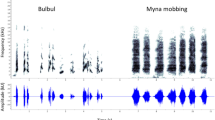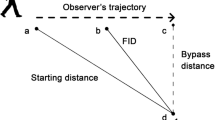Abstract
Antipredator behavior includes several qualitatively distinct activities, but few studies have determined the degree to which these activities are independent. If behaviors are not independent, then the nature of the relationship would illustrate potential performance constraints. We studied crimson rosellas (Platycercus elegans) and first focused on acoustic predator discrimination. We measured time allocation before and after playback of one of three experimental treatments (peregrine falcons—Falco peregrinus, wedge-tailed eagles—Aquila audax, and crimson rosellas) to determine whether or not rosellas discriminated predators from non-predators, and specifically whether or not they discriminated large from small predators. We then focused on the decision to flee. We experimentally approached subjects and measured the distance at which they oriented to us (alert distance) and the distance at which they fled (flight initiation distance; FID). We found that rosellas could distinguish among predators; however, there was no effect on general wariness as measured by FID. These two processes of antipredator behavior may, thus, be independent.



Similar content being viewed by others
References
Blumstein DT (2003) Flight-initiation distance in birds is dependent on intruder starting distance. J Wildl Manage 67:852–857
Blumstein DT, Fernández-Juricic E, LeDee O, Larson E, Rodriguez-Prieto I, Zugmeyer C (2004) Avian risk assessment: effects of perching height and detectability. Ethology 110:273–285
Blumstein DT, Fernández-Juricic E, Zoolner PA, Garity SC (2005) Inter-specific variation in avian responses to human disturbance. J Appl Ecol 42:943–953
Blumstein DT, Daniel JC, Evans CS (2006) JWatcher 1.0: An introductory user’s guide. http://www.jwatcher.ucla.edu
Buckingham R, Jackson L (1985) A field guide to birdsong, cassette 2: rufous night heron to chestnut rail. Bird Observers Club, Nunawading, Victoria
Cárdenas YL, Shen B, Zung L, Blumstein DT (2005) Evaluating temporal and spatial margins of safety in galahs. Anim Behav 70:1395–1399
Caro T (2005) Antipredator defenses in birds and mammals. University of Chicago, Chicago
Cooper WE (1997) Threat factors affecting antipredatory behavior in the broad-headed skink (Eumeces laticeps): repeated approach, change in predator path, and predator’s field of view. Copeia 3:613–619
Deecke VB, Slater PJB, Ford JKB (2002) Selective habituation shapes acoustic predator recognition in harbour seals. Nature 420:171–173
Dial KP (2003) Evolution of avian locomotion: correlates of flight style, locomotor modules, nesting biology, body size, development, and the origin of flapping flight. Auk 120:941–952
Fichtel C, Kappeler PM (2002) Anti-predator behavior of group-living Malagasy primates: mixed evidence for a referential alarm call system. Behav Ecol Sociobiol 51:262–275
Gil-da-Costa R, Palleroni A, Hauser MD, Touchton J, Kelley J (2003) Rapid acquisition of an alarm response by a neotropical primate to a newly introduced avian predator. Proc R Soc London, Ser B 270:605–610
Grossman ML, Hamlet J (1988) Birds of prey of the world. Crown Publishers, New York, New York
Harder M (2000) Diet and breeding biology of the wedge-tailed eagle (Aquila audax) at three nest sites in north-eastern New South Wales. Corella 24:1–5
Hakkarainen H, Yli-Tuomi I, Korpimäki E, Ydenberg R (2002) Provisioning response to manipulation of apparent predation danger by parental pied flycatchers. Ornis Fenn 79:139–144
Hauser MD, Caffrey C (1994) Anti-predator response to raptor calls in wild crows, Corvus brachyrhynchos hesperis. Anim Behav 48:1469–1471
Hodos W, Erichsen JT (1990) Lower-field myopia in birds: an adaptation that keeps the ground in focus. Vision Res 30:653–658
Krebs EA (1998) Breeding biology of crimson rosellas (Platycerus elegans) on Black Mountain, Australian Capital Territory. Aust J Zool 46:119–136
Lank DB, Ydenberg RC (2003) Death and danger at migratory stopovers: problems with “predation risk”. J Avian Biol 34:225–228
Lima SL, Bednekoff PA (1999) Back to the basics of antipredatory vigilance: cannonvigilant animals detect attack? Anim Behav 58:537–543
Lima SL, Dill LM (1990) Behavioral decisions made under the risk of predation: a review and prospectus. Can J Zool 68:619–640
Martin P, Bateson P (1986) Measuring behaviour: an introductory guide. Cambridge University Press, Cambridge
Olsen J, Debus S, Rose AB, Hayes G (2004) Breeding success, cliff characteristics of peregrine falcon at high altitude in Australian Capital Territory. Corella 28:33–37
Palleroni A, Hauser M, Marler P (2005) Do responses of galliform birds vary adaptively with predator size? Anim Cognit 8:200–210
Pizzey G (1980) A field guide to the birds of Australia. Princeton University Press, Princeton
Rainey HJ, Zuberbühler K, Slater PJB (2004) The responses of black-casqued hornbills to predator vocalisations and primate alarm calls. Behaviour 141:1263–1277
Searcy YM, Caine NG (2003) Hawk calls elicit alarm and defensive reactions in captive Geoffroy’s marmosets (Callithrix geoffroiyi). Folia Primatol 74:115-125
Sharp A, Gibson L, Norton M, Ryan B, Marks A, Semararo L (2002) Breeding season diet of the wedge-tailed eagle (Aquila audax) in western New South Wales and influence of rabbit calicivirus disease. Wildl Res 29:175-184
Stubbs T (1996) http://users.tpg.com.au/users/vanh/4.4.1_variety.html
Swaisgood RR, Rowe MP, Owings DH (1999) Assessment of rattlesnake dangerousness by California ground squirrels: exploitation of cues from rattling sounds. Anim Behav 57:1301-1310
Templeton CN, Greene E, Davis K (2005) Allometry of alarm calls: black-capped chickadees encode information about predator size. Science 308:1934-1937
Tobalske BW, Dial KP (2000) Effects of body size on take-off flight performance in the Phasianidae (Aves). J Exp Biol 203:319-3332
Ydenberg RC, Dill LM (1986) The economics of fleeing from predators. Adv Study Behav 16:224-229
Acknowledgements
For permission to work in Booderee National Park, we thank the National Park staff and the Wreck Bay Aboriginal Community. Additionally, we thank Tony Davidson for permission to work on the H.M.A.S. Creswell. We thank the UCLA Department of Ecology and Evolutionary Biology, the Lida Scott Brown Ornithology Trust, and the UCLA Office of Instructional Development for their generous support. Special thanks go to Brian Smith for help in the field and the lab, Benjamin Theule for editorial help and insight, and Eve Buigues for support. We thank Peter Bednekoff and three anonymous reviewers for extremely constructive criticism on a previous version.
Author information
Authors and Affiliations
Corresponding author
Additional information
Communicated by P. Bednekoff
Rights and permissions
About this article
Cite this article
Adams, J.L., Camelio, K.W., Orique, M.J. et al. Does information of predators influence general wariness?. Behav Ecol Sociobiol 60, 742–747 (2006). https://doi.org/10.1007/s00265-006-0218-9
Received:
Revised:
Accepted:
Published:
Issue Date:
DOI: https://doi.org/10.1007/s00265-006-0218-9




